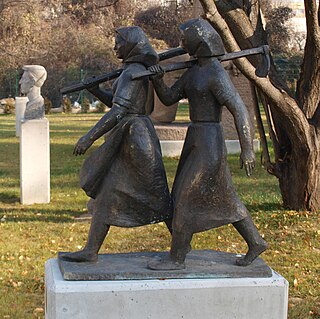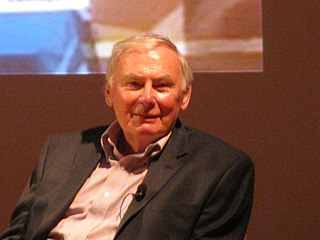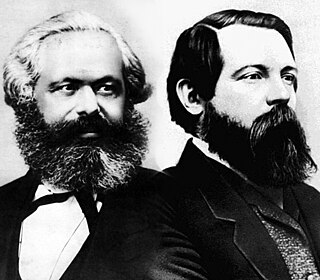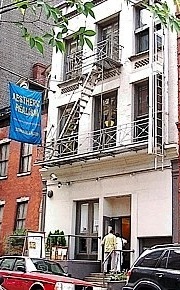
Aesthetics is a branch of philosophy that deals with the nature of art, beauty and taste and with the creation or appreciation of beauty.

Socialist realism is a style of idealized realistic art that was developed in the Soviet Union and was imposed as the official style in that country between 1932 and 1988, as well as in other socialist countries after World War II. Socialist realism is characterized by the glorified depiction of communist values, such as the emancipation of the proletariat. Despite its name, the figures in the style are very often highly idealized, especially in sculpture, where it often leans heavily on the conventions of classical sculpture. Its similarity to the art of the Third Reich is unmistakable, and the two are often grouped together as heroic realism. Although related, it should not be confused with social realism, a type of art that realistically depicts subjects of social concern, or other forms of "realism" in the visual arts.
Eli Siegel was the poet, critic, and educator who founded Aesthetic Realism, the philosophy that sees reality as the aesthetic oneness of opposites. An idea central to this philosophy—that every person, place or thing in reality has something in common with all other things—was expressed in his award-winning poem, "Hot Afternoons Have Been in Montana."
Magical realism, magic realism, or marvelous realism is a style of fiction that paints a realistic view of the modern world while also adding magical elements. It is sometimes called fabulism, in reference to the conventions of fables, myths, and allegory. "Magical realism", perhaps the most common term, often refers to fiction and literature in particular, with magic or the supernatural presented in an otherwise real-world or mundane setting.

Social realism is the term used for work produced by painters, printmakers, photographers, writers and filmmakers that aims to draw attention to the real socio-political conditions of the working class as a means to critique of the power structures behind these conditions. While the movement's characteristics vary from nation to nation, it almost always utilizes a form of descriptive or critical realism. Taking its roots from European Realism, Social Realism aims to reveal tensions between an oppressive, hegemonic force, and its victims.
In metaphysics, realism about a given object is the view that this object exists in reality independently of our conceptual scheme. In philosophical terms, these objects are ontologically independent of someone's conceptual scheme, perceptions, linguistic practices, beliefs, etc.
Poetic realism was a film movement in France of the 1930s. More a tendency than a movement, poetic realism is not strongly unified like Soviet montage or French Impressionism but were individuals who created this lyrical style. Its leading filmmakers were Pierre Chenal, Jean Vigo, Julien Duvivier, Marcel Carné, and, perhaps the movement's most significant director, Jean Renoir. Renoir made a wide variety of films some influenced by the leftist Popular Front group and even a lyrical short feature film. Frequent stars of these films were Jean Gabin, Michel Simon, Simone Signoret, and Michèle Morgan.

Richard Estes is an American artist, best known for his photorealist paintings. The paintings generally consist of reflective, clean, and inanimate city and geometric landscapes. He is regarded as one of the founders of the international photo-realist movement of the late 1960s, with such painters as John Baeder, Ralph Goings, Chuck Close, Audrey Flack, and Duane Hanson. Author Graham Thompson writes "One demonstration of the way photography became assimilated into the art world is the success of photorealist painting in the late 1960s and early 1970s. It is also called super-realism or hyper-realism and painters like Richard Estes, Denis Peterson, Audrey Flack, and Chuck Close often worked from photographic stills to create paintings that appeared to be photographs."
This is an alphabetical index of articles about aesthetics.
Literature of the 19th century refers to world literature produced during the 19th century. The range of years is, for the purpose of this article, literature written from (roughly) 1799 to 1900. Many of the developments in literature in this period parallel changes in the visual arts and other aspects of 19th-century culture.

Marxist aesthetics is a theory of aesthetics based on, or derived from, the theories of Karl Marx. It involves a dialectical and materialist, or dialectical materialist, approach to the application of Marxism to the cultural sphere, specifically areas related to taste such as art, beauty, etc. Marxists believe that economic and social conditions, and especially the class relations that derive from them, affect every aspect of an individual's life, from religious beliefs to legal systems to cultural frameworks. From one classic Marxist point of view, the role of art is not only to represent such conditions truthfully, but also to seek to improve them ; however, this is a contentious interpretation of the limited but significant writing by Marx and Engels on art and especially on aesthetics. For instance, Nikolay Chernyshevsky, who greatly influenced the art of the early Soviet Union, followed the secular humanism of Ludwig Feuerbach more than he followed Marx.
Literary realism is part of the realist art movement beginning with mid-nineteenth-century French literature (Stendhal), and Russian literature and extending to the late nineteenth and early twentieth century. Literary realism attempts to represent familiar things as they are. Realist authors chose to depict everyday and banal activities and experiences, instead of using a romanticized or similarly stylized presentation.

Classical Realism refers to an artistic movement in late-20th and early 21st century in which drawing and painting place a high value upon skill and beauty, combining elements of 19th-century neoclassicism and realism.

A Universal History of Infamy, or A Universal History of Iniquity, is a collection of short stories by Jorge Luis Borges, first published in 1935, and revised by the author in 1954. Most were published individually in the newspaper Critica between 1933 and 1934. Angel Flores, the first to use the term "magical realism", set the beginning of the movement with this book.

Realism, sometimes called naturalism, in the arts is generally the attempt to represent subject matter truthfully, without artificiality and avoiding artistic conventions, or implausible, exotic, and supernatural elements. Realism has been prevalent in the arts at many periods, and can be in large part a matter of technique and training, and the avoidance of stylization.

The Terrain Gallery, or the Terrain, is an art gallery and educational center at 141 Greene Street in SoHo, Manhattan, New York City. It was founded in 1955 with a philosophic basis: the ideas of Aesthetic Realism and the Siegel Theory of Opposites, developed by American poet and educator Eli Siegel. Its motto is a statement by Siegel: "In reality opposites are one; art shows this."

Chaim Koppelman was an American artist, art educator, and Aesthetic Realism consultant. Best known as a printmaker, he also produced sculpture, paintings, and drawings. A member of the National Academy of Design since 1978, he was president of the Society of American Graphic Artists (SAGA), which presented him with a Lifetime Achievement Award in 2004. He established the Printmaking Department of the School of Visual Arts in 1959, and taught there until 2007.
Realism, Realistic, or Realists may refer to:










